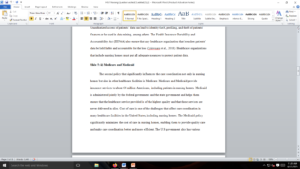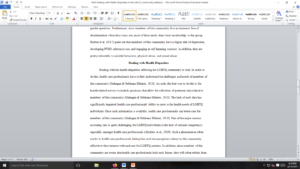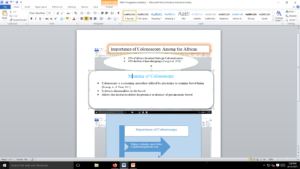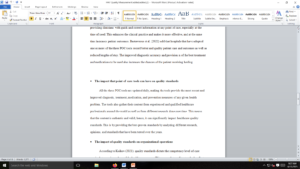Ill do the audio voice over. I just need powerpoint and narrative script.
Select a community organization or group that you feel would be interested in learning about ethical and policy issues that affect the coordination of care. Then, develop and record a 10-12-slide, 20-minute presentation, with audio, intended for that audience. Create a detailed narrative script or speakers notes for your presentation, 4-5 pages in length.
Introduction
As coordinators of care, nurses must be aware of the code of ethics for nurses and health policy issues that affect the coordination of care within the context of the community. To help patients navigate the continuum of care, nurses must be proficient at interpreting and applying the code of ethics for nurses and health policy, specifically, the Affordable Care Act (ACA). Being knowledgeable about ethical and policy issues helps ensure that care coordinators are upholding ethical standards and navigating policy issues that affect patient care.
This assessment provides an opportunity for you to develop a presentation for a local community organization of your choice, which provides an overview of ethical standards and relevant policy issues that affect the coordination of care. Completing this assessment will strengthen your understanding of ethical issues and policies related to the coordination and continuum of care, and will empower you to be a stronger advocate and nursing professional.
It would be an excellent choice to complete the Vila Health: Ethical Decision Making activity prior to developing the presentation. The activity provides a helpful update on the ethical principles that will help with success in this assessment.
Preparation
Your nurse manager at the community care center is well connected and frequently speaks to a variety of community organizations and groups. She has noticed the good work you are doing in your new care coordination role and respects your speaking and presentation skills. Consequently, she thought that an opportunity to speak publicly about contemporary issues in care coordination would be beneficial for your career and has suggested reaching out to a community organization or support group to gauge their interest in hearing from you, as a care center representative, on a topic of interest to both you and your prospective audience.
You have agreed that this is a good idea and have decided to research a community organization or support group that might be interested in learning about ethical and policy issues related to the coordination of care. Your manager has suggested the following community organizations and support groups, but acknowledges that the choice is yours.
- Homeless shelters.
- Local religious groups.
- Nursing homes.
- Local community organizations (Rotary Club or Kiwanis Club).
To prepare for this assessment, you may wish to:
- Research your selected community organization or support group.
- Review the Code of Ethics for Nurses With Interpretive Statements and associated health policy issues, specifically, the ACA.
- Review the assessment instructions and scoring guide to ensure you understand the work you will be asked to complete.
- Allocate sufficient time to rehearse your presentation before recording the final version for submission.
Instructions
For this assessment:
Presentation Format and Length
You may use PowerPoint (recommended) or other suitable presentation software to create your slides and add your voice over. If you elect to use an application other than PowerPoint, check with your faculty to avoid potential file compatibility issues.
Be sure that your slide deck includes the following slides:
- Title slide.
- Presentation title.
- Your name.
- Date.
- Course number and title.
- References (at the end of your presentation).
Your slide deck should consist of 10-12 slides, not including a title and references slide with typed speaker notes and audio voice over. Your presentation should not exceed 20 minutes.
Create a detailed narrative script for your presentation, approximately 4-5 pages in length.
Supporting Evidence
Cite 3-5 credible sources from peer-reviewed journals or professional industry publications to support your presentation. Include your source citations on a references page appended to your narrative script.
Grading Requirements
The requirements outlined below correspond to the grading criteria in the Ethical and Policy Factors in Care Coordination Scoring Guide, so be sure to address each point. Read the performance-level descriptions for each criterion to see how your work will be assessed.
- Explain how governmental policies related to the health and/or safety of the community affect the coordination of care.
- Identify national, state, and local policy provisions that raise ethical questions or dilemmas for care coordination.
- What are the implications and consequences of specific policy provisions?
- What evidence do you have to support your conclusions?
- Assess the impact of the code of ethics for nurses on the coordination and continuum of care.
- Consider the factors that contribute to health, health disparities, and access to services.
- Consider the social determinants of health identified in Healthy People 2020 as a framework for your assessment.
- Provide evidence to support your conclusions.
- Communicate key ethical and policy issues in a presentation affecting the coordination and continuum of care for a selected community organization or support group. Either speaker notes or audio voice-over are included for a proficient score; both speaker notes and the audio voice over are included for a distinguished score.
- Present a concise overview.
- Support your main points and conclusions with relevant and credible evidence.
Competencies Measured
By successfully completing this assessment, you will demonstrate your proficiency in the course competencies through the following assessment scoring guide criteria:
- Competency 4: Defend decisions based on the code of ethics for nursing.
- Assess the impact of the code of ethics for nurses on the coordination and continuum of care.
- Competency 5: Explain how health care policies affect patient-centered care.
- Explain how governmental policies related to the health and/or safety of a community affect the coordination of care.
- Identify national, state, and local policy provisions that raise ethical questions or dilemmas for care coordination.
- Competency 6: Apply professional, scholarly communication strategies to lead patient-centered care.
- Communicate key ethical and policy issues in a presentation affecting the coordination and continuum of care for a selected community organization or support group. Either speaker notes or audio voice-over are included.
Requirements: 4-5 pages
Answer preview
Despite the many advantages that the Act has caused, it has also caused different injustices that eventually negatively affect proper care coordination. For instance, the Act limits immigrants from accessing quality and affordable healthcare services in healthcare facilities that include nursing homes. The Act also aimed at increasing the number of expanding the coverage of Medicaid (Alvarez et al., 2018). This raises a dilemma where the increased Medicaid would make many low-wage workers and patients from low-income families receive inferior programs and health care services. The increased coverage would also increase the national debt hence negatively affecting the federal and state health budget, which would eventually affect the coordination of care.
[1449 Words]

Code of ethics for nurses and health policy issues











